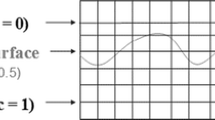Abstract
The real challenge is to establish a calculation model to predict the cylindricity of the honed cylinder liner before honing. In this paper, the relationship between honing parameters and the cylindricity of the cylinder liner is investigated; then a novel prediction model of the cylindricity of honed cylinder liner is proposed by considering the effect of honing parameters such as honing pressure, oilstone particle size, and overrunning distance on the material removal amount. The cylindricity of the honed cylinder liner is determined by the proposed model combining with the spatial trajectory of honing oilstone. The honing processing with different parameters is performed to obtain the cylindricities of honed cylinder liner. The predicted results by the proposed model are in good agreement with the measured cylindricities. The results show that the overrunning distance has a greater effect on the cylindricity of the honed cylinder liner, and a better cylindricity can be obtained when the honing pressure is lower. When the overrunning distance is 20 to 30% of the length of the oilstone, the cylindricity of the honed cylinder liner is better.
















Similar content being viewed by others
References
Cabanettes F, Dimkovski Z, Rosén BG (2015) Roughness variations in cylinder liners induced by honing tools’ wear. Precis Eng 41:40–46. https://doi.org/10.1016/j.precisioneng.2015.01.004
Lu Q, Zhou GH, Zhao F, Ren YP, Li XN, Sutherland JW (2019) Topology optimization of oilstone components considering carbon emissions associated with honing processes. J Clean Prod 225:181–195. https://doi.org/10.1016/j.jclepro.2019.03.273
Ma SQ, Liu YC, Wang ZC, Wang Z, Huang RX, Xu JJ (2019) The effect of honing angle and roughness height on the tribological performance of CuNiCr iron liner. Metals 9(5):487. https://doi.org/10.3390/met9050487
Keribar R, Dursunkaya Z, Flemming MF (1991) An integrated model of ring pack performance. J Eng Gas Turbines Power 113(3):382–389. https://doi.org/10.1115/1.2906242
Paswan SK, Bedi TS, Singh AK (2017) Modeling and simulation of surface roughness in magnetorheological fluid based honing process. Wear 376-377:1207–1221. https://doi.org/10.1016/j.wear.2016.11.025
Sun J, Huang X, Liu GS, Zhao XY, Miao EM, Zhu GX (2018) Research on the status of lubricating oil transport in piston skirt-cylinder liner of engine. J Tribol 140(4):041702. https://doi.org/10.1115/1.4038960
Taylor CM (1998) Automobile engine tribology-design considerations for efficiency and durability. Wear 21(1):1–8. https://doi.org/10.1016/S0043-1648(98)00253-1
Grabon W, Pawlus P, Wos S, Koszela W, Wieczorowski M (2017) Effects of honed cylinder liner surface texture on tribological properties of piston ring-liner assembly in short time tests. Tribol Int 113:37–148. https://doi.org/10.1016/j.triboint.2016.11.025
Buj-Corral I, Rodero-De-Lamo L, Marco-Almagro L (2017) Use of results from honing test machines to determine roughness in industrial honing machines. J Manuf Process 28:60–69. https://doi.org/10.1016/j.jmapro.2017.05.016
Buj-Corral I, Álvarez-Flórez J, Domínguez-Fernández A (2019) Effect of grain size and density of abrasive on surface roughness, material removal rate and acoustic emission signal in rough honing processes. Metals 9(8):860. https://doi.org/10.3390/met9080860
Buj-Corral I, Sivatte-Adroer M, Llanas-Parra X (2020) Adaptive indirect neural network model for roughness in honing processes. Tribol Int 141:105891. https://doi.org/10.1016/j.triboint.2019.105891
Sivatte-Adroer M, Lianas-Parra X, Buj-Corral I, Vivancos-Calvet J (2016) Indirect model for roughness in rough honing processes based on artificial neural networks. Precis Eng 43:505–513. https://doi.org/10.1016/j.precisioneng.2015.09.004
Lawrence KD, Ramamoorthy B (2016) Multi-surface topography targeted plateau honing for the processing of cylinder liner surfaces of automotive engines. Appl Surf Sci 365:19–30. https://doi.org/10.1016/j.apsusc.2015.12.245
Vates UK, Sharma S, Mittal VK (2017) Optimisation of honing process parameters for reducing surface roughness and power consumption on grey cast iron (FG-260I). International Journal of Additive and Subtractive Materials Manufacturing 1(1):67–81. https://doi.org/10.1504/IJASMM.2017.082987
Sadizade B, Araee A, Oliaei SNB, Farshi VR (2020) Plateau honing of a diesel engine cylinder with special topography and reasonable machining time. Tribol Int 146:106204. https://doi.org/10.1016/j.triboint.2020.106204
Zhang X, Wang X, Wang D, Yao Z, Xi L, Wang X (2017) Methodology to improve the cylindricity of engine cylinder bore by honing. J Manuf Sci Eng 139(3):031008. https://doi.org/10.1115/1.4034622
Qin PP, Yang CL, Huang W, Xu GW, Liu CJ (2016) Honing process of hydraulic cylinder bore for remanufacturing. In 2015 4th International Conference on Sensors. Measurement and Intelligent Materials Atlantis Press. https://doi.org/10.2991/icsmim-15.2016.14
Fang S, Klein S, Hsu CJ, Llanes L, Gachot C, Bähre D (2019) Fabrication and tribological performance of a laser-textured hardmetal guiding stone for honing processes. Int J Refract Met Hard Mat 84:105034. https://doi.org/10.1016/j.ijrmhm.2019.105034
Lu Q, Zhou GH, Zhao F, Li L, Ren YP (2019) Determination of shape and distribution of abrasive grains to reduce carbon emissions of honing process. J Manuf Sci Eng 141(2). https://doi.org/10.1115/1.4041481
Zhao X, Tan Y, Zhou Z, Wu K (2018) Processing technology of cylinder liners for high-power two-stroke diesel engines. China Mechanical Engineering 29(23):2875–2881
Kim ES, Kim SM, Lee YZ (2018) The effect of plateau honing on the friction and wear of cylinder liners. Wear 400-401:207–212. https://doi.org/10.1016/j.wear.2017.09.028
Yurdakul M, Gunes S, Ic YT (2016) Improvement of the surface quality in the honing process using Taguchi method. J Fac Eng Archit Gazi Univ 31(2):347–360
Demir A, Sonmez FO (2004) Prediction of Brinell hardness distribution in cold formed parts. J Eng Mater-T ASME 126(4):398–405. https://doi.org/10.1115/1.1789960
Zhang YD (2007) Modern honing technology. Science Press, Beijing
Huang JQ (2011) Fundamentals of mechanical manufacturing technology. Machinery Industry Press, Beijing
Funding
The work is supported by the National Natural Science Foundation of China (Grant No. 51775428), The Key Research and Development Program of Shaanxi Province of China (Grant No. 2020GY-106), and the Open Project of State Key Laboratory for Manufacturing Systems Engineering (Grant No. sklms2020010).
Author information
Authors and Affiliations
Corresponding author
Additional information
Publisher’s note
Springer Nature remains neutral with regard to jurisdictional claims in published maps and institutional affiliations.
Rights and permissions
About this article
Cite this article
Lu, Y., Li, J., Liang, R. et al. Investigation on the effect of honing parameters on cylindricity of engine cylinder liner. Int J Adv Manuf Technol 111, 3111–3122 (2020). https://doi.org/10.1007/s00170-020-06321-7
Received:
Accepted:
Published:
Issue Date:
DOI: https://doi.org/10.1007/s00170-020-06321-7




